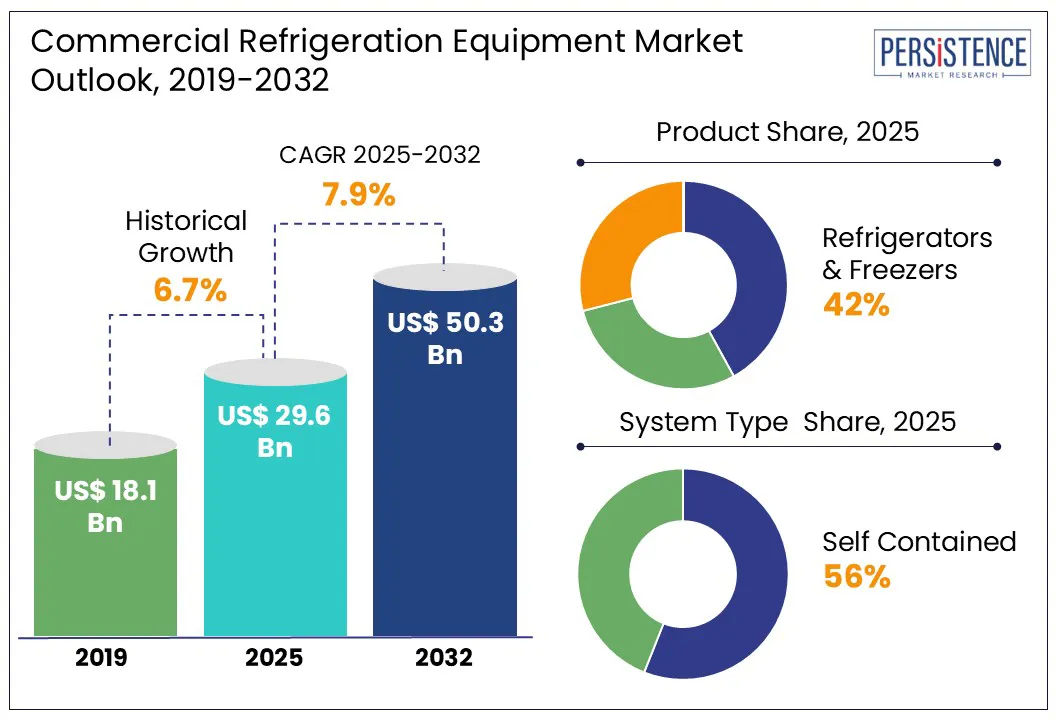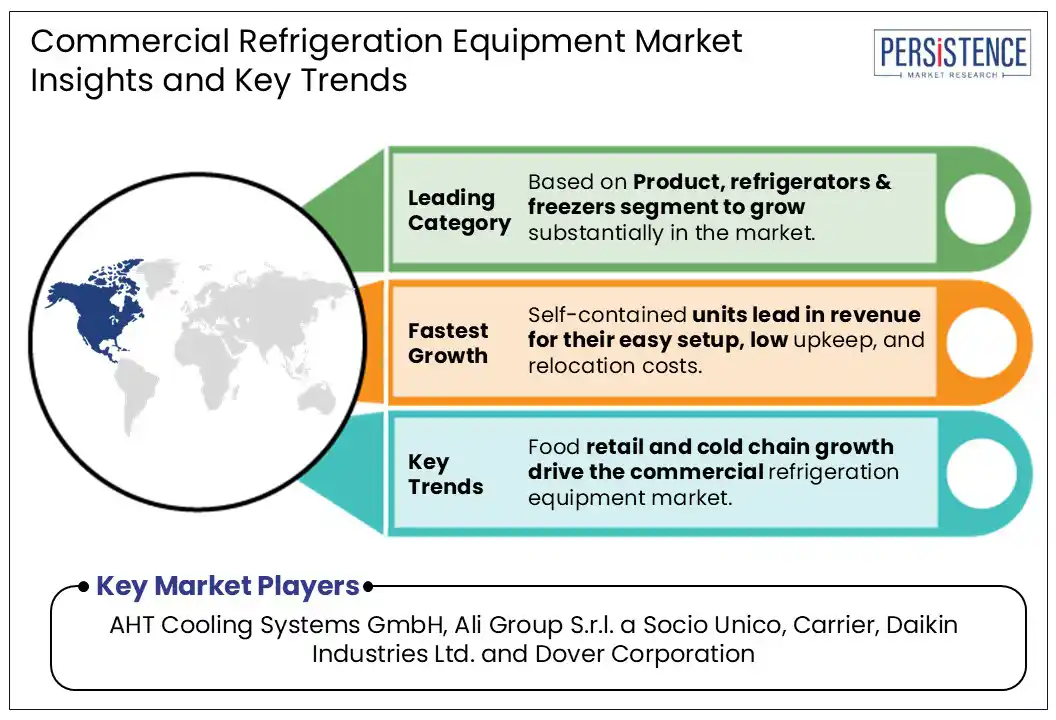ID: PMRREP2790| 195 Pages | 23 Jun 2025 | Format: PDF, Excel, PPT* | Industrial Automation

The global commercial refrigeration equipment market size is likely to be valued US$ 29.6 Bn in 2025 and is expected to reach US$ 50.3 Bn by 2032, growing at a CAGR of 7.9% in the forecast period from 2025 to 2032.
The growing demand for frozen foods, bakery items, and packaged food products is significantly boosting the commercial refrigeration equipment market. In response to the rise in environmental concerns, manufacturers are developing energy-efficient refrigeration systems to reduce carbon footprints. Regulatory bodies such as the U.S. Department of Energy and the Environmental Protection Agency have introduced stringent standards aimed at improving energy efficiency and reducing environmental impact.

Key Industry Highlights:
|
Global Market Attribute |
Key Insights |
|
Commercial Refrigeration Equipment Market Size (2025E) |
US$ 29.6 Bn |
|
Market Value Forecast (2032F) |
US$ 50.3 Bn |
|
Projected Growth (CAGR 2025 to 2032) |
7.9% |
|
Historical Market Growth (CAGR 2019 to 2024) |
6.7% |
The expansion of food retail chains, supermarkets, convenience stores, and foodservice establishments worldwide significantly contributes to the demand for commercial refrigeration equipment.
With the increasing global population and urbanization trends, the need for efficient cold storage and display solutions for perishable goods is escalating. Additionally, changing consumer lifestyles, including the growing preference for fresh and healthy foods, drive the demand for refrigeration equipment capable of preserving product quality and safety.
In response to these market trends, manufacturers are developing specialized refrigeration systems tailored to the needs of specific applications, such as chilled display cabinets, walk-in coolers, and refrigerated transport units. These solutions are designed to optimize space utilization, ensure food safety, and enhance the overall shopping and dining experience for consumers.
One of the primary restraints for the global commercial refrigeration equipment market is the rise in stringent regulatory environment. Governments worldwide are implementing strict energy efficiency standards and environmental regulations to reduce greenhouse gas emissions and promote sustainable practices. For instance, regulations such as the European Union's Eco-design Directive and the US Department of Energy's (DOE) Minimum Energy Performance Standards (MEPS) mandate minimum energy efficiency levels for commercial refrigeration equipment.
Compliance with these regulations requires manufacturers to invest heavily in research and development to design and produce energy-efficient refrigeration systems. Meeting these standards often involves incorporating advanced technologies such as high-efficiency compressors, improved insulation materials, and smart control systems. These enhancements increase manufacturing costs and may result in higher prices for consumers, thereby impacting market adoption rates, especially in price-sensitive markets.
Government agencies and R&D organizations are actively working to enhance the coefficient of performance, operational efficiency, lifespan, and cost-effectiveness of commercial refrigeration systems. In response to global climate agreements like the Kyoto Protocol and EU F-Gas regulations, manufacturers are prioritizing the development of natural refrigerant technologies to increase energy efficiency and reduce environmental impact. Leading companies such as Carnot Refrigeration, Danfoss, and Carrier Commercial Refrigeration are deploying ammonia and CO?-based technologies. Once limited to niche applications, cascade refrigeration systems using CO? and ammonia are now increasingly adopted due to heightened awareness of eco-friendly solutions.
The Clean Development Mechanism (CDM), outlined in Article 12 of the Kyoto Protocol, incentivizes such advancements by allowing countries with emission-reduction obligations to earn Certified Emission Reduction (CER) credits through projects that lower emissions. These projects include installing energy-efficient refrigeration equipment in industrial sectors, aligning economic incentives with sustainability goals, and supporting the shift toward greener cooling technologies.
The growth of the refrigerators & freezers segment can be ascribed to the global proliferation of the travel and tourism, which has resulted in the establishment of numerous eateries and dining establishments. The chapter also discusses blast chillers, which are mostly utilized for rapid freezing or cooling of things at lower temperatures and preventing bacterial growth in the stored item.
In addition, the increasing use of chillers by healthcare practitioners to preserve tissue samples of vaccinations, conduct controlled testing, and keep important pharmaceuticals is also driving the expansion of this sector. Furthermore, the growing popularity of 'grab and go' and 'drink and shop' practices in retail chains, aimed at enhancing the shopping experience for customers, is anticipated to fuel the demand for beverage commercial refrigerators in the approaching years.
The self-contained category dominated the global commercial refrigeration equipment market in terms of revenue. This was due to the increasing demand for these appliances, which can be easily and cost-effectively installed, require low maintenance, and have low relocation costs.
According to data from the Environmental Protection Agency (EPA), self-contained commercial refrigeration equipment accounted for approximately 26% of global HFC emissions in 2020. Manufacturers are being forced to replace the R-404A refrigerant with R-448A due to strict HFC emission regulations. This replacement reduces the global warming potential (GWP) of refrigeration equipment by around 70%.
These refrigerators produce less noise that resonates compared to self-contained refrigerators since the compressor unit is located outside the kitchen. Nevertheless, they have worse energy efficiency and necessitate the expertise of specialists for installation, hence exacerbating the already substantial installation expenses.

The Asia Pacific region is projected to experience a CAGR of over 6.4% from 2023 to 2030. This growth can be attributed to factors such as improving economic conditions, stable employment rates, increasing gross disposable income, and higher spending on leisure activities like travel, and dining out.
The commercial refrigeration equipment market in China is expected to witness a growth at CAGR of nearly 6.0% from 2024 to 2032. High-quality and fresh food products in China drives demand for commercial refrigeration equipment. In addition, high adoption rate of vaccine storage units across research institutions and biopharmaceutical companies in the country drives the market growth.
The commercial refrigeration equipment market in Japan accounted for over 20% revenue share of the Asia Pacific market in 2022. Rising demand for efficient and space-saving refrigeration solutions owing to the limited space availability and high population density is supporting the growth of the commercial refrigeration equipment market in Japan.
North America held a significant portion of the worldwide commercial refrigeration equipment market, with a revenue share exceeding 34%. The substantial expansion can be ascribed to the well-established retail sector and the presence of prominent supermarket chains, such as Walmart, Costco, Kroger, and Publix.
In addition, the significant presence of prominent manufacturers of commercial refrigeration equipment, with the early adoption of intelligent equipment in commercial kitchen is contributing to the growth of the regional market. The enormous demand for commercial refrigeration equipment from the food, beverage, pharmaceutical, and chemical sectors fuels more growth.
The Europe commercial refrigeration equipment market was valued at approximately USD 3.56 billion in 2025. Growth is driven by expanding food service and retail sectors, rising demand for energy-efficient and environmentally friendly refrigeration technologies, and increasing consumer preference for frozen and chilled products. The supermarket and hypermarket segments dominate the market, supported by the rapid expansion of organized retail chains across Europe.
Germany and France are key markets due to their strong food service industries, and stringent environmental regulations are pushing manufacturers to innovate with energy-saving compressors, smart controls, and sustainable refrigerants. Additionally, the rise of online grocery shopping and meal delivery services is fueling demand for reliable refrigeration solutions to maintain product freshness during transit. Leading manufacturers in Europe focus on integrating AI and automation to enhance efficiency and reduce energy consumption, aligning with the EU’s goals for carbon emission reduction and sustainability in commercial refrigeration.
The competitive landscape of the global commercial refrigeration equipment market is characterized by the presence of numerous established players and a growing influx of innovative entrants. Leading manufacturers are increasingly investing in R&D to develop energy-efficient and environmentally friendly refrigeration solutions. As regulatory standards become stringent, companies are focusing on sustainable technologies, such as low-GWP refrigerants and smart control systems to gain a competitive edge.
Strategic collaborations and partnerships are emerging as key trends, with manufacturers teaming up with technology firms, academic institutions, and research organizations to co-develop next-generation refrigeration systems. Major players are enhancing their global footprints through mergers, acquisitions, and joint ventures to access new markets and expand their product portfolios.
Customization capabilities, after-sales service, and compliance with international standards have become essential competitive factors. The integration of IoT and AI into commercial refrigeration systems is setting new benchmarks, intensifying competition among manufacturers, and striving for technological leadership and operational excellence.
The market is set to reach US$ 29.6 Bn in 2025.
The rising demand for frozen and processed foods, expansion of food service and retail sectors are the major growth drivers.
The industry is estimated to rise at a CAGR of 7.9% through 2032.
Growing demand for energy-efficient and eco-friendly solutions, and the rise in international food trade and cold chain logistics are key market opportunities.
AHT Cooling Systems GmbH, Ali Group S.r.l. a Socio Unico, Carrier, Daikin Industries Ltd. and Dover Corporation are a few leading players.
|
Report Attribute |
Details |
|
Historical Data/Actuals |
2019 - 2024 |
|
Forecast Period |
2025 - 2032 |
|
Market Analysis |
US$ Billion for Value |
|
Geographical Coverage |
|
|
Segmental Coverage |
|
|
Competitive Analysis |
|
|
Report Highlights |
|
|
Customization and Pricing |
Available upon request |
By Product
By Application
By System Type
By Region
Delivery Timelines
For more information on this report and its delivery timelines please get in touch with our sales team.
About Author